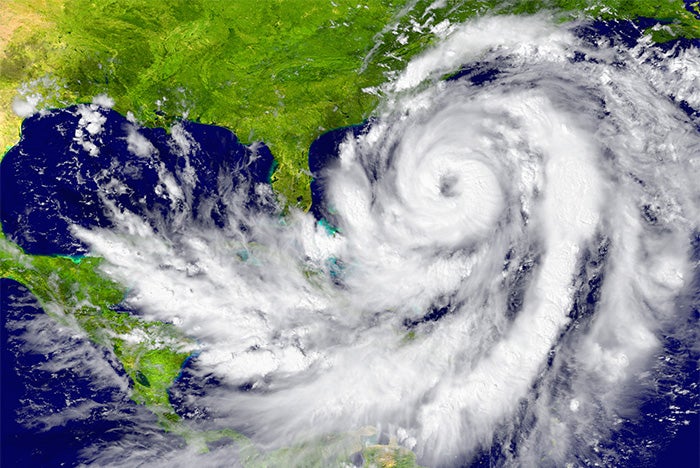Health care facilities prepare for worsening impacts of climate change
Editor’s note: This article is part of a series on the impacts of climate change and climate events on hospitals and health care facilities and related planning, preparedness and response efforts.

Image from Getty Images
Flooding during a tropical storm inundates three floors of a hospital. Smoke and ash from wildfires strain a health care facility’s air filtration system. The high winds of a hurricane damage the roof and windows of a medical center tower. Soaring record-high temperatures cause brownouts that require a clinic to switch over to generator power.
This article series has explored different climate-related threats to health care facilities: extreme heat and cold, drought, hurricanes, wildfires and flooding. Trends indicate that these events will continue to increase in severity and frequency as climate change continues to exacerbate the conditions that result in disaster.
While these threats may differ in their specific impacts, cycles and seasons, and necessary preparedness and planning strategies, common themes among them do exist and are worth exploring.
Essential early planning and preparedness
Health care facilities must anticipate that climate-related disasters will occur and prepare for worst-case scenarios. The devasting aftermath of hurricanes, particularly Hurricane Sandy and Hurricane Katrina, show that preparing for the most severe impacts is essential. Climate event impacts might also be unexpected, as was the case with Hurricane Ida, a slow-moving tropical storm that dropped a tremendous amount of rainfall and caused flooding in eastern states.
Supplies needed for response and recovery will likely be difficult or impossible for health care facilities to acquire once a disaster event has occurred. Carondelet Health Network in Tucson, Ariz., was prepared to deal with a catastrophic chiller failure during a severe heatwave because it had procured portable chillers, generators and air conditioners beforehand, which were otherwise unavailable during the heatwave. A priority for Texas Children’s Hospital in Houston has been the acquisition of resources, including food and water, needed for shelter-in-place procedures after flooding as well as building supplies such as sheet rock and plywood.
Climate threats and disasters are interconnected
The effects of climate change can create a cascade of outcomes, with impacts exacerbating conditions immediately or over time.
Drought, for example, has led to dry conditions that have made the areas around Sky Lakes Medical Center in Klamath Falls, Ore., more vulnerable to wildfires. Severe wildfires have contributed to water and air pollution, soil contamination, erosion and flooding, posing challenges for Kaiser Permanente facilities in California. The extreme cold in Texas in 2021 resulted in frozen sprinkler lines and chilled water lines at Children’s Health in Dallas that then burst and caused flooding in the facility.
As health care facilities plan and prepare for climate-related disasters, threats cannot be considered standalone issues. Instead, holistic approaches that recognize the relationships between these impacts are akin to a spiderweb with complex interactions are what hospitals need for successful planning, response and recovery. The overlap of strategies for different climate events is also important to identify. In the case of Children’s Health, the winter storm preparedness in many ways resembled hurricane planning protocols.
Health care facilities managers play a key role
Individuals often seek hospitals for medical care, relief assistance and access to resources during and after a climate events .
For example, extreme heat can disable power grids, and people without air conditioning may seek refuge at hospitals. The community health impacts of wildfires from smoke and poor air quality mean that more people will come to hospitals for medical care. Events such as these underscore the importance of having health care facilities up and running during and after a climate-related disaster.
Health care facilities managers have an opportunity to lead the way in pursuing environmental sustainability options for the essential infrastructure and equipment that enable facilities to remain open during climate disasters. They can implement solutions that offer a host of benefits to their organizations, including improved energy efficiency, a reduction in greenhouse gas emissions and increased resiliency. In addition, the ripple effect of these decisions extends far beyond the physical structures themselves and help to combat climate change locally, regionally and globally.
Sharing insight, information and resources
Health care facilities across the country have been affected by each of the climate events reviewed in this series. More than 20 years ago flooding from Tropical Storm Allison destroyed Texas Children’s Hospital in Houston. The individuals who experienced that catastrophic event ensured that those hard-learned lessons would inform flood planning for future health care facilities. Today, facilities managers have a similar wealth of knowledge and first-hand experience to share with their colleagues as they collectively contend with a host of climate uncertainties.
Facilities managers must also collaborate inside and outside of their organizations to effectively prepare for climate events. Internal coordination with health services and administrative departments, emergency management teams and sustainability staff will help in developing robust response and recovery plans. Likewise, connecting with other hospitals, and local, regional and state agencies in order to share information and resources can help to sharpen procedures. For instance, the Carondelet Health Network leveraged established relationships with business partners to ensure rental equipment was readily available during systems failures due to extreme heat.
Sustainability, equity and public health converge
Climate change highlights the intersection of the work health care organizations do and its impacts on the patients they serve. Vulnerable populations — including low-income communities, communities of color, children and the elderly — are more likely to suffer the negative health effects of climate change and the devasting impacts of climate-related events.
MetroHealth System based in Cleveland, CommonSpirit Health and Kaiser Permanente have taken action within their organizations and communities to address environmental and health equity issues. These organizations recognize that their role as health care providers is linked to community health and well-being. Because climate change and its effects run counter to those values, a shift in priorities has realigned the missions of these organizations with the goal of improving public health and community health outcomes using environmentally sound practices.
Preparing for the future
Health care facilities managers will need to plan and prepare for the climate change impacts that are likely to come, which means bolstering the resiliency of their facilities. But it also means proactively taking actions that address the source of these threats — climate change. Over the long term, sustainability efforts such as decarbonization and improved energy efficiency will help health care facilities reach zero carbon emissions while maintaining high-quality care for the patients, staff and communities they serve.
Learn More
- The National Academy of Medicine (NAM) launched the Action Collaborative on Decarbonizing the U.S. Health Sector, a public-private partnership to address environmental impacts, sustainability and resilience in the health care sector.
- NAM is also sponsoring the Grand Challenge on Climate Change, Human Health & Equity, a global initiative to transform systems at the intersection of climate, health and equity.
- The Office of Climate Change and Health Equity of the Department of Health and Human Services offers a webinar series, Accelerating Healthcare Sector Action on Climate Change and Health Equity, on a variety of topics related to climate change, resilience and emissions reductions.
- The U.S. Climate Resilience Toolkit is a compilation of resources from federal agencies and organizations and includes the Sustainable and Climate-Resilient Health Care Facilities Toolkit, a framework to help health care facilities plan and prepare for climate change and extreme weather events.





